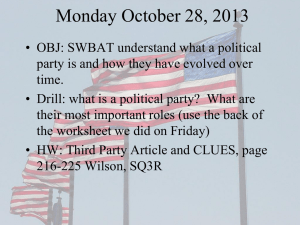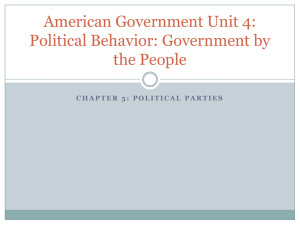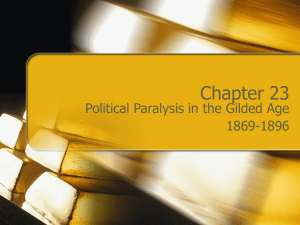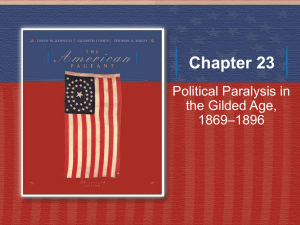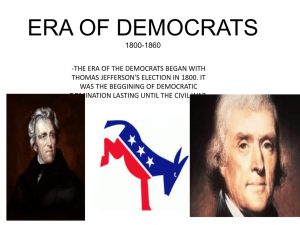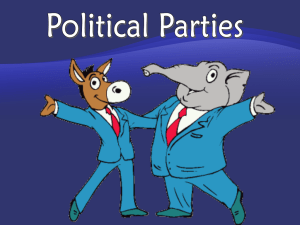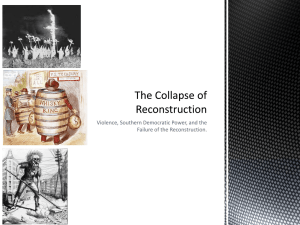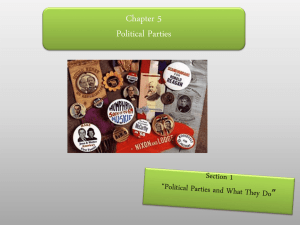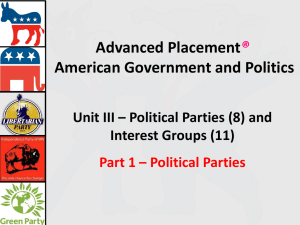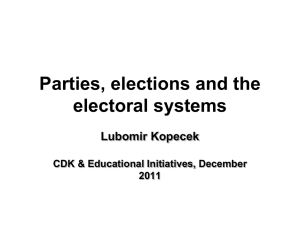realignments
advertisement
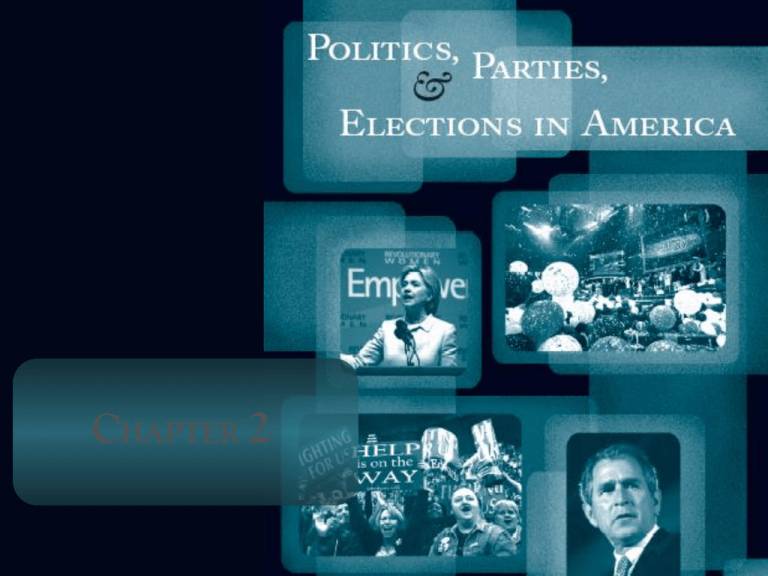
CHAPTER 2 The Party Battle in America Throughout American party history, there have been periodic electoral realignments: The occurrence of significant changes within the electorate: - a minority party becomes the majority party - dominance by one party through an infusion of strength - significant changes in the partisan loyalties of voters Realignments tend to occur when major crises intrude on the society and economy Party Realignment in American History The five attributes of Realignment: 1. The regional support for the parties changes 2. The social groups supporting the parties change 3. New groups of citizens are mobilized and become part of the electorate 4. Voter change not just which party they vote for, but also the party that they identify with 5. Realignments are typically caused by new issues that divide citizens Five realignments have occurred in the United States (1828, 1860, 1896, 1932, and 1968) These are used to divide American political history into six party systems The First Party System, 1788 - 1824 Competing parties: Federalists vs. Democratic-Republicans Parties emerged in the 1790s in the policy conflict between Hamilton and Jefferson: - Hamilton and the Federalists promoted business interests and sided with the British - Jefferson and the Democratic-Republicans promoted agricultural interests and sided with the French Extension of party organization to the local level Nomination of presidential candidates by party caucuses in Congress The First Party System, 1788 - 1824 In the 1800 election, Jefferson defeated Adams After this, the Federalists suffered a sharp decline - Federalist failure to respond to the popular and democratic style of politics that was developing - By 1816 the Federalists disappeared as a national political party capable of contesting for the presidency After 1820 the Democratic-Republican Party was characterized by factionalism Since Congress lacked an opposition party, the caucus system for presidential nominations collapsed The Second Party System, 1828 - 1854 Competing parties: Democrats vs. Whigs The 1828 and 1832 elections, both won by Andrew Jackson, were fought in an era of bifactional politics within the dominant Democratic-Republican Party In the 1832 election, Jackson ran under the new label “Democratic Party” By 1834, the groups opposed to Jackson’s politics had coalesced sufficiently to form an opposition party – the Whigs The Second Party System, 1828 - 1854 The two decades following Jackson’s reelection in 1932 were characterized by balanced two-party competition A significant expansion of the electorate through democratization and increased participation intensified this struggle Both the Democrats and the Whigs were truly national parties with organizations both at the regional and the state levels The Third Party System, 1856 - 1896 Competing parties: Republicans vs. Democrats Resulting from a national divide on the issue of slavery, the existing parties split into Northern and Southern factions Unable to solve this internal conflict the Whig party dissolved after the election in 1854 At the same time, the anti-slavery Republican Party was founded in the North The Third Party System, 1856 - 1896 From 1862 to 1874 the Republican Party dominated, by forging an alliance between farmers and business interests After 1874 the southern-based Democrats gained enough support in the North to enable balanced two-party competition Party machines, or patronage-based party organizations, using the exchange of services for votes, grew strong during this period Party machines were weakened through the introduction of Australian (secret) ballots The Fourth Party System, 1896 - 1928 Competing parties: Republicans vs. Democrats The economic and social changes following the industrialization of America posed new problems for the political system In 1896 the Democrats reacted to new economic challenges by adopting the People’s Party (Populist) platform, initiating economic reforms At the same time, Republicans received an infusion of support, especially in growing urban areas The Fourth Party System, 1896 - 1928 Following the 1996 election the Republican Party dominated throughout this era, with one exception: An intraparty Republican schism, leading to two Republican candidates running for the presidency, thus splitting the Republican vote, enabled the election of Democrat Woodrow Wilson in 1912 After World War I, the Republicans asserted their dominance with victories in 1920, 1924, and 1928 The legal environment of parties changed during this era, with the introduction of direct primaries, state laws on primaries and campaign finance Sectionalism in American Politics during the Post-Civil War Era and Early 20th Century 1880 1904 James Garfield (Republican) – 214 Electoral Votes Winfield Hancock (Democrat) – 155 Electoral Votes Theodore Roosevelt (Republican) – 336 Electoral Votes Alton B. Parker (Democrat) – 140 Electoral Votes The Fifth Party System, 1932 - 1968 Competing parties: Republicans vs. Democrats Following the Great Depression and the 1932 election, a new period of Democratic dominance began The New Deal coalition that supported Franklin D. Roosevelt was formed, including a variety of groups The New Deal social welfare policies further weakened patronage-based urban party machine, depriving these of their traditional service functions The Fifth Party System, 1932 - 1968 In the 1950s the Coalition began to fray, resulting from a North/South split over welfare policies and civil rights issues After the Republicans won back both the presidency and Congress in 1952, an era of divided party control of the government began The New Republican administration and Congress accepted the New Deal policies with minor changes, thus eliminating these as a divisive force The Sixth Party System, 1968 Competing parties: Republicans vs. Democrats The traditional state of electoral partisanship underwent significant changes in the late 1960s: - increased participation and Democratic affiliation among black voters, as Democrats endorsed Civil Rights laws - declined partisanship as more voters identified themselves as independent - white Southerners, once a mainstay of the Democrat electoral coalition, became Republican - support for the Democrats declined among their other traditional supporters, such as Catholics and The Sixth Party System, 1968 These forces, together with television as the new dominant campaign medium, helped creating a candidate-centered party system Other indicators of the weakening of party ties among voters is the emergence of strong thirdparty candidates and increased split-ticket voting The most significant change during this period took place in the South, which underwent a substantial realignment that would fundamentally alter the landscape of party politics in America, enabling the Republicans to take control of Congress in 1994 Percent Affiliating with the Republican Party in the South and Non-South, 1956-2004 Percent Non-South South Source: National Election Studies Minor Parties in American Politics Renewed interest in minor parties was sparked in the 1990s, through the candidacies of Ross Perot in 1992 and 1996, and Ralph Nader in 2000 The rise of third parties reflects the inability of the major parties to meet the expectations of the public Third parties and independent candidates have helped to bring certain issues onto the public agenda Several minor parties have existed independently at the state level on the basis of local bases of support Several states have elected third-party or independent Governors The Two-Party System: Some Explanations Throughout the party history of the United States, the following characteristics can be observed: Normally, just two major parties compete for power Parties rely on broad-based coalitions of citizens The Democratic and Republican parties are quite durable features in American political life Several potential explanations for the prevalence of this pattern of two-party competition exist The Two-Party System: Some Explanations The institutional explanation: French political scientist Maurice Duverger proposed that the basis for the two-party system is the singlemember district electoral system: - since only one party can win in any given district, only two parties have a reasonable chance of victory Two-party competition is also encouraged by the College system for choosing presidents Electoral - the requirement of winning an absolute majority of the electoral votes makes a third-party candidate victory unlikely The direct primary and presidential primary systems, and the Federal Election Campaign Act (FECA) constitute additional barriers for third-parties The Two-Party System: Some Explanations The historical explanation: The parties managed to renew themselves within different dualist conflicts and cleavage patterns throughout the history of American party systems The cultural explanation: American society has not been characterized by as strong ideological and class divisions as European societies Instead, it has become possible for one party to be slightly left of the center (liberal) and the other to be slightly right of the center (conservative), and still gain widespread electoral support Parties as Coalitions Throughout their history, American parties have been broadly based coalitions: - both majority and minority party have attracted significant support from virtually every element of society Party coalitions change over time, in response to new crises and issues An important consequence of the coalition nature of parties is that intraparty conflicts can be crucial in shaping the direction of governmental policy and the nature of party competition Three types of party competition has existed since 1800: Balanced two-party competition, one-party dominance, and transitional pluralism The Stability of the Republican-Democratic Conflict since 1860 Since 1860, the Republicans and Democrats have confronted each other as the major combatants in the electoral arena, both sustaining dramatic swings in support. How could this conflict be so durable? The parties are capable of absorbing protest emerging from third-party movements The parties are ideologically eclectic, enabling the coexistence of a wide variety of viewpoints The parties have exhibited coalitional flexibility, enabling the attraction of votes from all elements of society Republican and Democratic Percentages of the Popular Vote for President, 1892-2004 Percent 100 50 0 Other candidates Republicans Democrats
